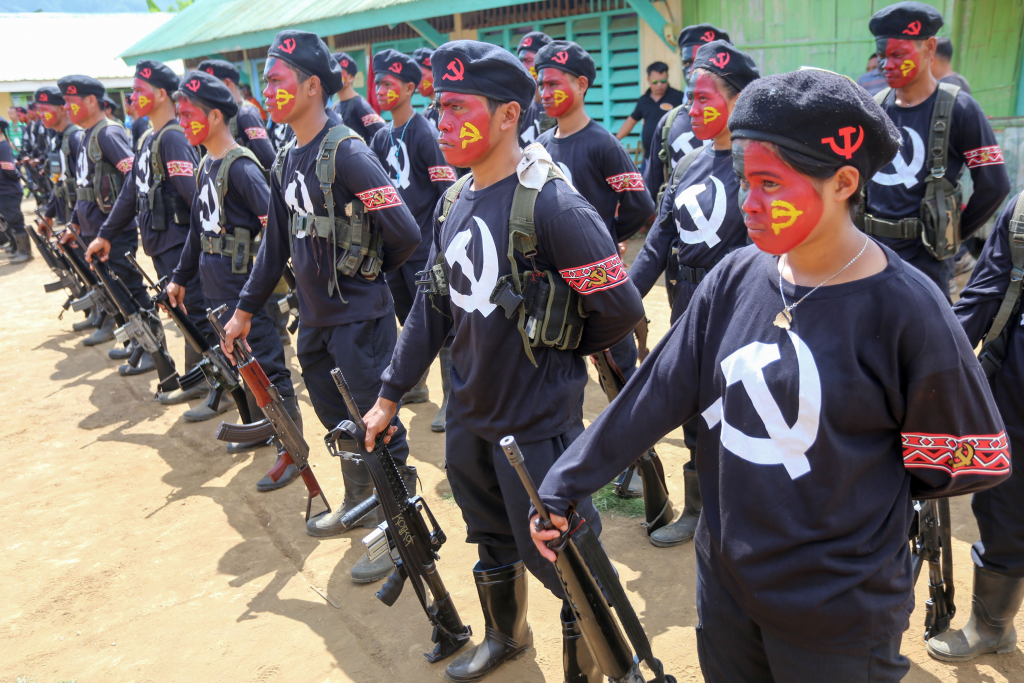To what extent does Marxism advocate the use of violence in pursuing political aims; specifically, when does class struggle become armed struggle?
Communism is certainly not a pacifist ideology. Throughout history, Communist Parties, and organisations in which Communists have played a leading role, have resorted to armed struggle, either in self-defence or in order to further revolutionary aims. Examples include socialist revolutions, national liberation struggles and anti-imperialist wars of national defence. Indeed, violent struggle has often played a key role in social transformation, far predating Communist influence. Some would even argue that violence itself is necessary for revolutionary change.
In his introduction to Virtue and Terror, a collection of writing by Robespierre, Slavoj Zizek talks about the concept of ‘divine violence’. This he illustrates by referring to the “Revolutionary Terror of France 1792-94”, the “Red Terror of Russia 1919” and “the panic in Rio de Janeiro when crowds descended from the favelas into the rich part of the city and started looting and burning supermarkets” as examples. In his later book Violence he argues that violence is the key to revolution; that no revolution, nor revolutionary, can be sustained without violence.
In this, he appeals again to Robespierre – “Peoples do not judge in the same way as courts of law; they do not hand down sentences, they throw thunderbolts; they do not condemn kings, they drop them back into the void; and this justice is worth just as much as that of the courts” – and to Che Guevara – “Hatred is an element of struggle; relentless hatred of the enemy that impels us over and beyond the natural limitations of man and transforms us into effective, violent, selective, and cold killing machines.” – and closes with an “endorsement of emancipatory violence”, declaring that “[i]f one means by violence a radical upheaval of the basic social relations, then, crazy and tasteless as it may sound, the problem with historical monsters who slaughtered millions was that they were not violent enough. Sometimes doing nothing is the most violent thing to do.”
In spite of his entertaining literary acrobatics and somewhat cavalier attitude towards definitions, there are some serious flaws in this approach. Primarily, in focusing exclusively on the role of violence in transforming social relations (or even redefining violence as such a transformation), Zizek neglects the basis of such a transformation itself. This is to be found in the changing economic basis of society and the classes engaged in this.
It may seem excessive to spend so long on the views of someone who, it cannot be denied, occupies an extreme position on the spectrum of Marxist thought. One good reason for doing this is the fact that these ideas are repeated throughout history. An example of this is the way in which Zizek’s idolisation of ‘divine violence’ is reminiscent of the approach of Debray and others in the ‘New Left’ of the 1960s and 1970s towards the lessons of the Cuban Revolution. Debray argued that the guerrilla fighter had effectively replaced the working class in playing a leading role in revolutionary transformation and that the Communist Parties had become redundant through their prioritisation of political above armed struggle.
However, there is another reason to focus so much on an extreme position. Zizek’s mistakes may well point the way to the crucial aspect of the question. That is that revolutions are made, and social relations changed, by classes, not just their most advanced sections. The key question for Marxists is not one of ‘divine violence’ or a small select group of armed revolutionaries inspiring the backward masses through their heroic actions. It is a question of the organic link between those carrying out the armed struggle and the mass of ordinary people whose active support will be necessary to win.
As Enrique Lister, Communist General in the Spanish Civil War, put it, “guerrilla units were a vital necessity at the time and they played a tremendous role. But the guerrillas alone could not deliver Spain from Franco. The overthrow of the dictatorship necessitated the participation of the people on a mass scale… In organising a guerrilla movement one should never confuse popular sympathy with popular support; these are two different things. In Spain the guerrillas enjoyed the sympathy of the people who regarded them as heroes. But the sympathy did not go beyond that. It never became the active and massive support for the guerrilla operations that was essential and on which the guerrillas had counted.”
Similarly, Lenin argued that, “insurrection must rely not upon conspiracy and not upon a party, but upon the advanced class… Insurrection must rely upon a revolutionary upsurge of the people.” He also stressed that guerrilla warfare should not be elevated above other forms of struggle. “The party of the proletariat,” he wrote, “can never regard guerrilla warfare as the only, or even the chief, method of struggle… this method must be subordinated to other methods… must be commensurate with the chief methods of warfare.”
None of this is to suggest that armed struggle should not be used as a tactic in a revolutionary situation. Indeed, it is difficult to imagine any revolution in which armed struggle does not play a major role, whether in Britain or elsewhere. “Armed struggle is a necessity, as the final step in the overthrow of imperialism, not because of the illegal character of the Party, but because of the nature of imperialism itself.” (Philippine Communist Party).



